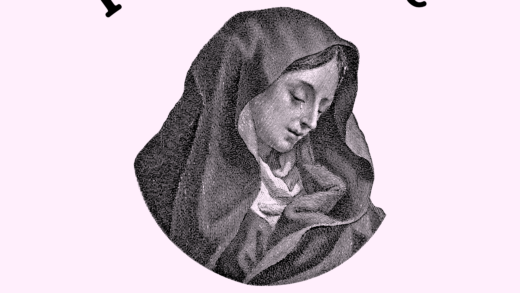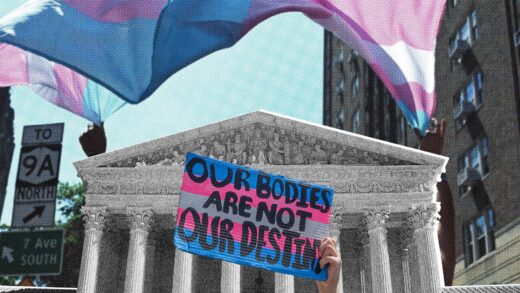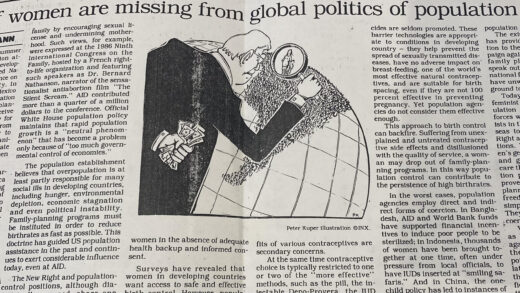
by Charli Kellaway
This podcast gives an insider look at the psychological impact of the HIV/AIDs epidemic, but more specifically the impact that it had, and continues to have on the queer community. Studies show that there is more hostility, criticism, and public scrutiny that queer people have entailed, which in a sense creates an increase of psychological issues for HIV/AIDs positive, queer individuals. Virgina Apuzzo, a leading civil rights lecturer and an executive director for the LGBTQ Task Force, describes in her papers this trend, giving insight into the societal patterns of AIDs-related discrimination, the response of the gay community, and what we must do to combat the the future of stigmatization in today’s world.
Transcript – Queer Perspective: Psychological Effects of AIDS
Hello and welcome to Herstory with Charli, a podcast dedicated to topics in women’s empowerment, reproductive justice, and gender equality
This podcast is brought to you by Smith College. I’m your host, Charli Kellaway and you’re listening to Episode 01: “Queer Perspective: Psychological effects of AIDS” .
In this episode, we’re going to talk about the toll AIDS took on the mental health of queer individuals, families, and communities, particularly during the height of the epidemic in the 1980s and 90s. We’ll also discuss the pioneering work of Virginia Apuzzo, whose papers shed light on the psychological consequences of the AIDS crisis, and how we move beyond that. Her research continues to influence how we view the intersection of health, stigma, and mental well-being
All right, let’s get into it. Before we can talk about the trends in psychology amongst queer people, we must provide context to why it has left the impact it has.
Partly because of its unique relationship to gender inequality and cultural conceptions of sexuality, HIV/AIDS is one of the most difficult public health issues to discuss, along with being one of the most challenging medical conditions to treat clinically. Infection with HIV most commonly begins with transmission of the virus during unprotected sex. Children who are born to an HIV-infected mother can become infected with the virus during pregnancy, childbirth, or breastfeeding. HIV can also be transmitted through contact with contaminated blood, a transmission route most often associated with the sharing of needles by injection drug users.1
From the very beginning, the AIDS crisis was not just a health emergency—it was a societal trauma that left lasting scars, especially for the queer community. These invisible wounds shaped not only left the individuals affected, but also the cultural and psychological landscape of entire generations.
The AIDS epidemic began to be noticed in the early 1980s, primarily among gay men, though it quickly became clear that HIV didn’t discriminate based on sexual orientation, gender, or race. Yet, the stigma surrounding HIV/AIDS was immense, fueled by fear, misinformation, and prejudice. For example, even our own president Ronald Reagan failed to address the health crisis for years, and often used popular homophobic rhetoric, claiming AIDS was the “gay plague”.2 This stigma around the disease played a significant role in the mental health crisis that followed, forcing the queer community to be put in an extremely vulnerable position.
This is where Virginia Apuzzo’s work becomes particularly important. Apuzzo, a scholar and advocate, was one of the key voices who during her tenure with New York City’s Department of Public Health, became one of the earliest, most vocal female AIDS activists in the country. In New York she created a volunteer infrastructure to address the community’s needs and established one of the first telephone hotlines to help with AIDS education and resources. She focused on understanding not only the medical aspects of the epidemic but also the emotional and social consequences of living in a world where AIDS was stigmatized so heavily.
In Virgina Apuzzo’s paper entitled, The Psychological Impact of Aids Upon The Gay Community3, Apuzzo shares the scope of the impact that HIV/AIDs had on queer people. She explains how this community has been affected to a disproportionate extent, as 71% of people who have been diagnosed with HIV/AIDS have been gay or bisexual. She shares that efforts at quantitative evaluations conducted at UCLA in 1894 revealed that “persons with AIDS scored very high on scales measuring tensions, depression, and confusions.” (Apuzzo 1984, 3) A more subjective assessment revealed that “pervasive fears of invalidness, dependency, loneliness, abandonment, along with fear of physical disability, spreading their infection to others, and the fear of dying was also highly prevalent amongst the positively tested queer individuals” (Apuzzo 1984, 3), demonstrating that the psychological distress one feels may be exacerbated by any number of neurological disorders.
Among those whose lifestyle places themselves at a higher risk for AIDS, the epidemic has induced a rational fear and concern that has for many resulted in behavioral changes. Because of the everyday fear of losing your job, home, along with family and friends due to positively tested individuals sexuality, the extra stressor of contracting AIDS is proven by Apuzzos study that they enhance the ones individuals already are experiencing. This oftentimes results in higher then average rates of alcoholism, substance abuse, and and suicide rates. The rational response to objective danger can result in maladaptive behaviors and tendencies, including neurotic, phobia, hypochondriacal, anxiety ridden, neurasthenic, and obsessional behavior.4 In these cases, the rational response to danger can be disproportionate, overactive, or misguided due to the complexity of human emotions, perceptions, and cognitive processes. For example, obsessional behavior about contracting and living with the disease itself may impair social and occupational functioning, and in its most extreme form may result in an unfounded belief that they are actively dying potentially becoming suicidal or even committing suicide5.
Those impacted not only are forced to live in fear because of the status of their health, but they must also face a variety of other stressors due to their sexual orientation. Apuzzo says in her paper addressing the New York State Psychological Association6 that “People have always hated queers, though never had a good reason to hate them, but now, AIDS gives people a reason too,”(Apuzzo 1987, 13) giving explanation to why stigmatization and hate around the disease has been significant for so long. In her paper, she recognizes that everyone falls into the traps of stereotyping and blemish, and specifically calls out the professional world for not adequately stopping it sooner. She suggests that education to end this prejudice starts with mental health professionals, as she believes that “they need to be at the forefront of condemning such homophobic acts and aberrant behavior unhealthy to our society”. (Apuzzo 1987, 14) With that being said, she says that individuals “need to continue to educate themselves, need to see that the national and state organizations vigorously endorse educational programs for its members, and need to see what kind of education the next generation of health care providers are receiving.” (Apuzzo 1987, 9)
HIV/ AIDS has overwhelmingly impacted and created psychological distress amongst queer communities, and one of Appuzzo’s ideas on how to combat this through adequate medical and psychological training, along with proper resources for health care workers helping to combat the disease and its burdens. In the same paper, she explains how addressing the issue couldn’t wait, and that any psychologist that not only deals with the LGBTQ community but also the general public must be certified to deal with the disease, and know how it affects ones mental health.7 She says in her paper to the New York State Psychological Association that, “Whatever community that you are serving, you should be in touch with the AIDS resource center, the people with AIDS coalition, the Gay Men’s Health crisis, along with the American foundation for AIDS research, and make sure to have the most up to date information available to you”. (Apuzzo 1987, 11) She states that this effort of “going further”, and fixing the problem from its root is the most important and powerful to eliminating systematic hate, oppression, and violence.
As we wrap up today’s episode, I want to leave you with this thought: the psychological effects of AIDS are real, and they are lasting, but so is the power of community, support, and care. We are all connected, and while the AIDS epidemic continues to shape our history, we also have the opportunity to learn from it—especially when it comes to understanding the mental health needs of people living with HIV and AIDS, along with those affected by it.
That’s it for today’s episode, and thank you for tuning in to Herstory with Charli. Always remember to stay safe, stay informed, and be kind to each other. Take care.
- O’Brien, Jodi. “HIV/AIDS.” In Encyclopedia of Gender and Society, edited by O’Brien, Jodi, 426-30. Thousand Oaks, CA: SAGE Publications, Inc., 2009. https://doi.org/10.4135/9781412964517. ↩︎
- Lopez, German. 2016. “The Reagan Administration’s Unbelievable Response to the HIV/AIDS Epidemic.” Vox. Vox. December 1, 2016. https://www.vox.com/2015/12/1/9828348/ronald-reagan-hiv-aids. ↩︎
- Virginia Apuzzo papers, The Psychosocial Impact of Aids Upon The Gay Community, May 10, 1984, National Gay Task Force, Sophia Smith Collection, SSC-MS-00711, Smith College Special Collections,Northampton, Mass. ↩︎
- Handlovsky, Ingrid, Jessy Sidhu, Anthony Theodore Amato, Olivier Ferlatte, and Hannah Kia. 2024. “The Collective Trauma of HIV/AIDS and Contemporary Constructions of Health: Older Gay Men’s Perspectives.” SSM – Qualitative Research in Health, September, 100477–77. https://doi.org/10.1016/j.ssmqr.2024.100477. ↩︎
- Ferlatte, Olivier, Ingrid Handlovsky, Damien Ridge, Tara Chanady, Rod Knight, and John L. Oliffe. 2022. “Understanding Stigma and Suicidality among Gay Men Living with HIV: A Photovoice Project.” SSM – Qualitative Research in Health 2 (December): 100112. https://doi.org/10.1016/j.ssmqr.2022.100112. ↩︎
- Virginia Apuzzo papers, New York State Psychological Association, April 25, 1987, National Gay Task Force, Sophia Smith Collection, SSC-MS-00711, Smith College Special Collections,Northampton, Mass. ↩︎
- Virginia Apuzzo papers, New York State Psychological Association, April 25, 1987, National Gay Task Force, Sophia Smith Collection, SSC-MS-00711, Smith College Special Collections,Northampton, Mass. ↩︎
References
Art, AIDS & AA Bronson.” 2024. CATIE – Canada’s Source for HIV and Hepatitis c Information. April 26, 2024. https://www.catie.ca/positive-side/art-aids-aa-bronson.
Ferlatte, Olivier, Ingrid Handlovsky, Damien Ridge, Tara Chanady, Rod Knight, and John L. Oliffe. 2022. “Understanding Stigma and Suicidality among Gay Men Living with HIV: A Photovoice Project.” SSM – Qualitative Research in Health 2 (December): 100112. https://doi.org/10.1016/j.ssmqr.2022.100112.
Handlovsky, Ingrid, Jessy Sidhu, Anthony Theodore Amato, Olivier Ferlatte, and Hannah Kia. 2024. “The Collective Trauma of HIV/AIDS and Contemporary Constructions of Health: Older Gay Men’s Perspectives.” SSM – Qualitative Research in Health, September, 100477–77. https://doi.org/10.1016/j.ssmqr.2024.100477.
Human Rights Campaign. 2012. “HIV and the LGBTQ Community | Human Rights Campaign.” Human Rights Campaign. Human Rights Campaign. November 6, 2012. https://www.hrc.org/resources/hrc-issue-brief-hiv-aids-and-the-lgbt-community.
Lopez, German. 2016. “The Reagan Administration’s Unbelievable Response to the HIV/AIDS Epidemic.” Vox. Vox. December 1, 2016. https://www.vox.com/2015/12/1/9828348/ronald-reagan-hiv-aids.
O’Brien, Jodi. “HIV/AIDS.” In Encyclopedia of Gender and Society, edited by O’Brien, Jodi, 426-30. Thousand Oaks, CA: SAGE Publications, Inc., 2009. https://doi.org/10.4135/9781412964517.
“PIONEERING ACTIVIST.” n.d. Accessed November 20, 2024. https://lgbthistorymonth.com/sites/default/files/2016_LGBTHM_Bios.pdf.
“Reunion 2024 | Virginia Apuzzo | SUNY New Paltz.” 2024. Newpaltz.edu. 2024. https://www.newpaltz.edu/reunion-2024/awards/virginia-apuzzo–/.
Rosenfeld, Dana. 2018. “The AIDS Epidemic’s Lasting Impact on Gay Men.” The British Academy. 2018. https://www.thebritishacademy.ac.uk/blog/aids-epidemic-lasting-impact-gay-men/.
Virginia Apuzzo papers, New York State Psychological Association, April 25, 1987, National Gay Task Force, Sophia Smith Collection, SSC-MS-00711, Smith College Special Collections,Northampton, Mass.
Virginia Apuzzo papers, The Psychosocial Impact of Aids Upon The Gay Community, May 10, 1984, National Gay Task Force, Sophia Smith Collection, SSC-MS-00711, Smith College Special Collections,Northampton, Mass.
World Health Organization. 2024. “HIV/AIDS.” Www.who.int. World Health Organization. July 2024. https://www.who.int/data/gho/data/themes/hiv-aids.





![“Riot [Stonewall ’69… AIDS Crisis ‘89] (Sticker)” by Gran Fury (Art and Activist collective) via NYPL.](https://sites.smith.edu/listening-for-rj/wp-content/uploads/sites/836/2024/11/Riot_Stonewall_69_AIDS_Crisis_891.width-592.jpg)


